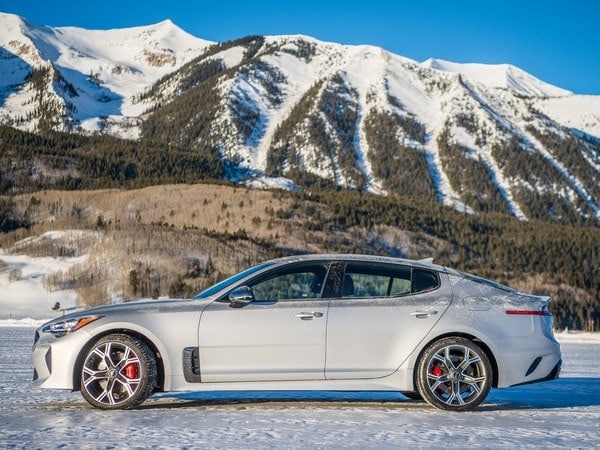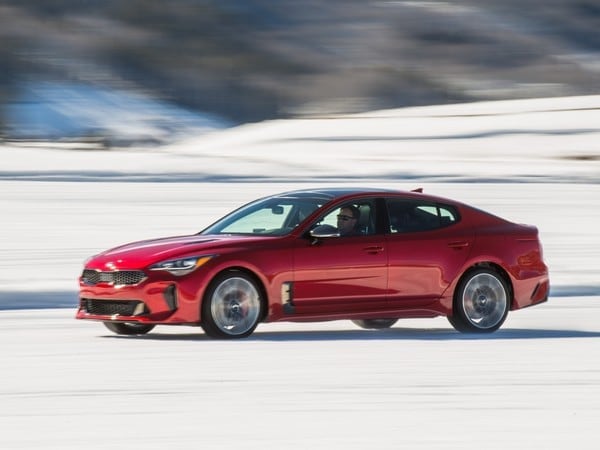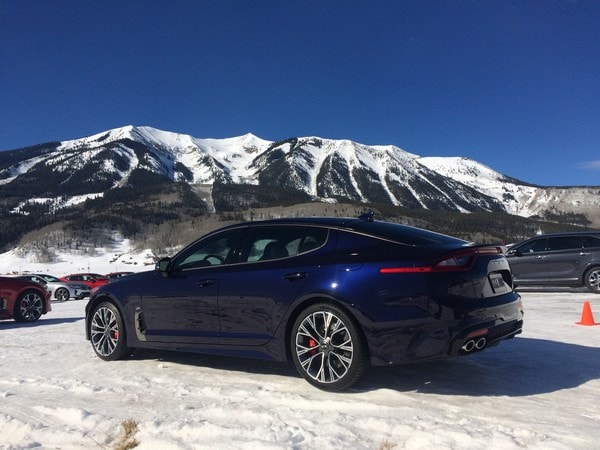Over the past several years Kia has been upping its game in design, alternative powertrains and in-car technology. It can add innovative all-wheel drive to its list of accomplishments. While Kia has long offered all-wheel drive (AWD) in its crossover SUVs for enhanced capability and traction in off-road and winter driving, its latest vehicle has it for another reason: performance.
The new Kia Stinger is the Korean brand’s first non-SUV to offer AWD, and according to brand executives it won’t be the last. In fact, the Stinger is a beacon of what’s ahead.
As a quick recap, the 2018 Kia Stinger is a performance sedan that benefits from a sleek 5-door liftback design. In addition to being Kia’s highest performing and arguably best looking vehicle to date, the Stinger has a practical X factor in a rear lift back door that hides a large cargo bay.
It’s other X-factor is all wheel drive, which can be had as an option instead of the standard rear wheel drive with either the Kia’s standard 255-horsepower turbocharged 4-cylinder engine or upgraded 365-horsepower twin-turbo V6. The Stinger’s all-wheel-drive system is distinct for a couple of reasons. The first is that, unlike a typical crossover setup which favors the front axle, the Stinger’s AWD is rear-wheel biased so that it behaves like a sports car. The second is that it’s an in-house development, another first for Kia, as opposed to other models such as the Sorento crossover SUV, which use an AWD system supplied by Magna. As with its laudable transmissions that are also homemade, the new AWD system can be tailored exactly to Kia’s own specification.
A signal of what’s to come
According to James Bell, Kia’s director of corporate communications, “All-wheel drive will become a pillar for Kia. Beyond performance and safety, it will have its own attraction.”
Part of that attraction is an AWD system that favors sportiness with a rear-drive bias. In the normal driving mode, the Stinger’s system is set to roughly a 40/60 split for sending power to the front and rear wheels, respectively. In sport mode it shifts the equation to a rear-biased 20/80. Yet the Stinger is smart enough to divvy power where it’s needed most, when it’s needed most. In freezing conditions, for example, more power is sent to the front wheels to ensure grip. According to Eddie Rayyan, the Kia Stinger’s product manager, the AWD system has the smarts to anticipate a driver’s intention. Moreover, the system’s in-house development paves the way for future learnings and applications.
Also: Get your first look at the new and redesigned cars of 2019
Control in a chaotic setting
To showcase the system, Kia invited us to push the Stinger to its limits on a private snow track in Crested Butte, Colorado. The benefits of such a setting are that you won’t tear up tires as you would on asphalt or hit walls (snow banks are far softer). Yet the slick environment still mimics how a car behaves when traction is compromised, albeit at lower speeds. For our purposes, the 2018 Kia Stingers we tested were all-wheel-drive V6 models, shod with Michelin Pilot Alpin PA4 winter tires.
A team of professional driving instructors set up three main segments in this freezing, high elevation (roughly 9,000 feet above sea level) playground: an emergency lane-change course, an autocross, and a longer and higher-speed track with plenty of twists and turns that allowed drifts and slides. In all three configurations, we toggled the between the various drive modes and through the Stinger’s traction and stability control settings to see what differences they played. Quite a lot, it turns out.
Unless you’re performing such a test yourself or hooning it up in a controlled environment, you would want to stay in either the “smart” or “comfort” modes in a wintry setting such as this. We started with the car in comfort mode and traction control on. In this mode, the Stinger was quick to quell out-of-control movements. In the emergency lane change, where we snapped the car to the left or right to get it to slide, the car was quick to get back in line when the tail kicked out.
Drift king
In sport mode, where power is rear-biased, it was easy to keep the tail out and drift by applying power and feeding in steering on the larger track. Doing so can make you feel like a rock star. That is, until you continue to defeat the safety systems, especially stability control. With all systems off, it was remarkable to experience just how much behind-the-scenes work the Stinger’s AWD system is doing to keep the car stable and controlled in such a potentially dangerous setting. And it humbles even those of us who think we’re experienced drivers.
Pushed on the snow track with none of the electronic safety nets, the Stinger spun out and lost grip easily with moderate throttle application. With the systems flipped back on, however, the Stinger stayed in check while making the person behind the wheel look like a far better driver.
This initial taste of Kia’s first in-house all-wheel-drive system, applied specifically to a performance vehicle, has whetted our appetite for what’s to come. Kia has already proven to be a forward thinker in terms of design, technology and even the warranties of its vehicles. If the Stinger is any indicator, we can soon add all-wheel-drive performance to its list of achievements.






























